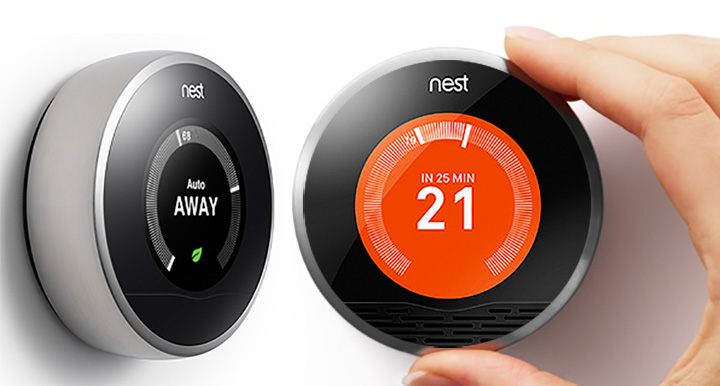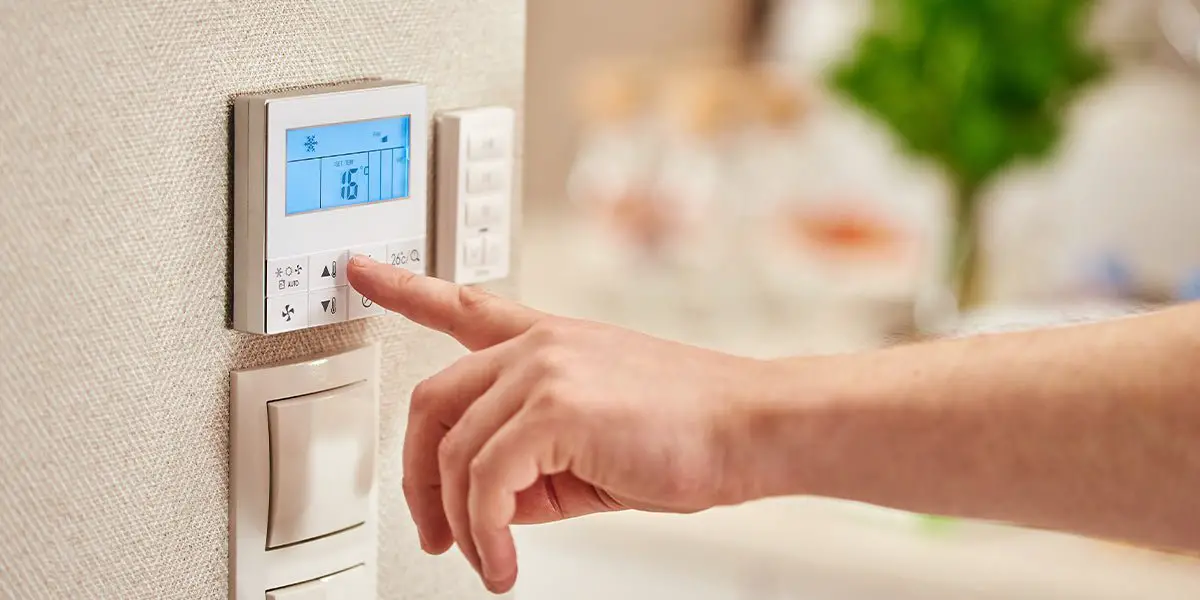Check Best Thermostat Pricing in Amazon
** As an Amazon Associate, I earn from qualifying purchases.
Set your thermostat to 7-10 degrees lower in winter or higher in summer when you’re away. This saves energy and reduces utility bills.
Managing your thermostat efficiently when you’re away from home can lead to significant energy savings. Adjusting the settings by 7-10 degrees helps maintain a comfortable environment without wasting energy. Smart thermostats make this even easier by allowing remote control and automation.
Consistently adjusting your thermostat settings reduces wear and tear on your HVAC system. This not only cuts down on energy consumption but also extends the lifespan of your equipment. Simple changes to your thermostat’s settings can result in lower utility bills and a more environmentally friendly home. Prioritize energy efficiency to enjoy these benefits and contribute to a sustainable future.

Credit: globalnews.ca
- The Importance Of Thermostat Settings
- Types Of Thermostats For Your Home
- Finding The Sweet Spot: Ideal Temperatures
- Smart Thermostats: Automation And Control
- Energy Savings: Maximizing Efficiency When Away
- The Role Of Insulation And Home Sealing
- Additional Tips For Managing Your Home Climate
- Monitoring And Adjusting: The Key To Continuous Savings
- Frequently Asked Questions
- Conclusion
The Importance Of Thermostat Settings
Proper thermostat settings can make a big difference in your home’s energy use. They can also impact your comfort and your energy bills. Setting the thermostat right is important whether you are home or away.
Energy Consumption And Costs
Thermostat settings play a crucial role in energy consumption. When you are away, lowering the temperature in winter or raising it in summer can save a lot of energy. This simple step can lead to significant cost savings on your energy bills.
Consider this table for a quick overview:
| Season | Home | Away |
|---|---|---|
| Winter | 68°F (20°C) | 60°F (15°C) |
| Summer | 78°F (25°C) | 85°F (29°C) |
As shown, adjusting the thermostat when away helps reduce energy use.
Home Comfort Vs. Energy Savings
Balancing home comfort and energy savings can be tricky. You want your home to be comfortable when you return. At the same time, you don’t want to waste energy.
Here are some tips:
- Use a programmable thermostat to set temperatures based on your schedule.
- Set the thermostat to change the temperature an hour before you come home.
- Consider a smart thermostat for more control and flexibility.
These steps can help you maintain comfort while saving energy.
Types Of Thermostats For Your Home
Choosing the right thermostat for your home can save energy and money. There are different types of thermostats, each with unique features. Here are three main types you should consider:
Manual Thermostats
Manual thermostats are the simplest type. You adjust the temperature by turning a dial or moving a lever. They are easy to use and affordable. Manual thermostats don’t have any programming features.
Advantages of Manual Thermostats:
- Simple to operate
- Low cost
- Reliable and durable
Programmable Thermostats
Programmable thermostats allow you to set a schedule for temperature changes. You can program different temperatures for different times of the day. This helps save energy by reducing heating or cooling when you are not home.
Features of Programmable Thermostats:
| Feature | Description |
|---|---|
| Scheduling | Set up to 7 days of temperature schedules |
| Energy Savings | Reduces energy use when you’re away |
| Digital Display | Easy to read and adjust settings |
Smart Thermostats
Smart thermostats are the most advanced type. They connect to your Wi-Fi and can be controlled via a smartphone app. Smart thermostats learn your preferences and adjust automatically. They can even detect when you are away and adjust the temperature accordingly.
Benefits of Smart Thermostats:
- Remote control via smartphone
- Learning capabilities for automatic adjustments
- Energy-saving features
Smart thermostats often integrate with other smart home devices. They provide detailed reports on energy usage, helping you save even more. These thermostats also offer voice control with devices like Amazon Alexa and Google Assistant.
Finding The Sweet Spot: Ideal Temperatures
Adjusting your thermostat when you are away is essential. It helps in saving energy and maintaining home comfort. The right temperature can make a big difference in energy bills. Let’s explore how to find the perfect temperature settings for different situations.
Seasonal Temperature Adjustments
Different seasons call for different thermostat settings. During winter, set the thermostat to 68°F when you’re awake. Lower it by 7-10°F when you’re away or sleeping. This can save up to 10% on heating costs.
In summer, set the thermostat to 78°F when you’re home and need cooling. Raise it by 7°F when you’re away. This simple adjustment can reduce cooling costs significantly.
Here’s a quick reference table:
| Season | Home | Away |
|---|---|---|
| Winter | 68°F | 60-61°F |
| Summer | 78°F | 85°F |
Health And Comfort Considerations
Temperature settings also affect your health and comfort. Very low temperatures can cause health issues. Too high temperatures can make you uncomfortable.
Avoid setting your thermostat too low in winter. It can cause respiratory problems. Keep it above 60°F to ensure a healthy environment. In summer, avoid setting it too high. It can lead to overheating and discomfort. Stick to the recommended 78°F for a comfortable home.
Here are some quick tips for health and comfort:
- Winter: Keep the thermostat above 60°F.
- Summer: Keep the thermostat around 78°F.
- Avoid extreme settings: They can cause discomfort and health issues.

Credit: www.youtube.com
Smart Thermostats: Automation And Control
Smart thermostats are changing how we manage home temperatures. They offer automation and control, saving energy and money. These devices are more than just temperature controllers. They learn your habits and adjust settings automatically. This blog explores the benefits of smart thermostats, focusing on automation and control.
Remote Temperature Management
One key feature of smart thermostats is remote temperature management. You can control your home’s temperature from anywhere. Use your smartphone, tablet, or computer. This ensures a comfortable home when you return. It also helps save energy while you are away.
Imagine you are on vacation. You can lower the temperature to save energy. Before you return, set it back to a comfortable level. This feature offers both convenience and cost savings.
Learning Your Schedule And Preferences
Smart thermostats do more than manual settings. They learn your schedule and preferences. Over time, they create a heating and cooling plan. This plan adjusts automatically based on your habits.
For example, the thermostat knows when you wake up and adjusts the temperature. It also knows when you leave for work and sets an energy-saving mode. This learning process ensures optimal comfort and efficiency.
Here is how it works:
- Initial Setup: Enter your usual schedule and temperature preferences.
- Learning Period: The thermostat observes your adjustments.
- Automatic Adjustments: It starts making changes on its own.
This smart feature means less manual work and more comfort. It’s like having a personal assistant for your home’s climate control.
Check Best Thermostat Pricing in Amazon
** As an Amazon Associate, I earn from qualifying purchases.
Energy Savings: Maximizing Efficiency When Away
When you leave home, your thermostat can help save energy. With smart settings, you can reduce costs and stay comfortable. This section explains how to maximize efficiency when you’re away.
Optimal Away Temperatures
Setting the right temperature when you’re not home is crucial. For winter, set your thermostat to 55°F to 60°F. This prevents pipes from freezing and saves energy. In summer, set it to 85°F to 90°F. This keeps your home cool enough without wasting energy.
Here’s a quick guide:
| Season | Optimal Temperature |
|---|---|
| Winter | 55°F – 60°F |
| Summer | 85°F – 90°F |
Vacation Mode Features
Many modern thermostats have a Vacation Mode. This feature helps you save energy when you’re away for a long time. You can set it to maintain specific temperatures for a set period.
Some benefits of Vacation Mode include:
- Easy Scheduling: You can program the thermostat in advance.
- Remote Control: Adjust settings from your smartphone.
- Energy Reports: Get insights into your energy usage.
Using Vacation Mode ensures your home is energy-efficient while you’re away. This feature can save you a lot on energy bills.
The Role Of Insulation And Home Sealing
Understanding the role of insulation and home sealing is key to efficient thermostat management when away. Proper insulation and sealing help maintain your home’s temperature. This reduces energy consumption and costs.
Maintaining Temperature Consistency
Insulation and home sealing play a crucial role in maintaining temperature consistency. Without proper insulation, your home loses heat in the winter and gains heat in the summer. This makes the thermostat work harder, consuming more energy.
Good insulation acts as a barrier. It keeps the warm air inside during winter and cool air inside during summer. Sealing gaps and cracks prevents air leaks. This ensures your home remains at a consistent temperature.
Here’s a table summarizing the benefits:
| Benefit | Description |
|---|---|
| Energy Efficiency | Reduces energy consumption by maintaining temperature. |
| Cost Savings | Lowers heating and cooling bills. |
| Comfort | Provides a consistent and comfortable indoor climate. |
Upgrading Insulation For Better Efficiency
Upgrading insulation can greatly improve your home’s energy efficiency. Start by assessing your current insulation. Determine if it’s adequate for your climate.
Consider these types of insulation:
- Fiberglass: Common and cost-effective.
- Spray Foam: Provides excellent sealing and insulation.
- Cellulose: Eco-friendly and effective.
Sealing your home is equally important. Use weather stripping around doors and windows. Caulk any gaps or cracks in the walls or foundation.
Follow these steps for better sealing:
- Inspect your home for air leaks.
- Apply weather stripping to doors and windows.
- Use caulk to seal gaps and cracks.
Proper insulation and sealing ensure your home stays energy-efficient. This makes your thermostat more effective when you’re away.
Additional Tips For Managing Your Home Climate
Managing your home climate while you are away can save you money and energy. Below are some additional tips to keep your home comfortable and efficient.
Utilizing Curtains And Blinds
Curtains and blinds play a crucial role in controlling your home’s climate. Close your curtains during the day to block out sunlight and reduce heat. Use light-colored curtains to reflect the sun’s rays. At night, open the curtains to let cooler air in. Blinds with slats can be tilted to control the amount of light and heat entering your home.
| Time of Day | Action |
|---|---|
| Day | Close curtains |
| Night | Open curtains |
The Impact Of Indoor Humidity
Indoor humidity affects the comfort and health of your home. High humidity can make your home feel warmer. Low humidity can cause dry skin and static electricity.
- Use a dehumidifier to reduce humidity in summer.
- Use a humidifier to add moisture in winter.
- Maintain indoor humidity between 30% and 50% for optimal comfort.
Check for leaks around windows and doors to prevent humidity issues. Houseplants can also help regulate indoor humidity.

Credit: www.reddit.com
Monitoring And Adjusting: The Key To Continuous Savings
Keeping an eye on your thermostat settings while away is crucial. This ensures continuous savings on energy bills. By monitoring and making necessary adjustments, you can optimize energy use. This leads to both cost savings and environmental benefits.
Regularly Reviewing Energy Bills
Make it a habit to regularly review your energy bills. This helps you understand your consumption patterns. Spotting unusual spikes in energy usage can alert you to potential issues. You can then take corrective action.
| Month | Energy Usage (kWh) | Cost ($) |
|---|---|---|
| January | 500 | 60 |
| February | 450 | 54 |
| March | 400 | 48 |
Use a table to track your monthly usage and costs. This makes it easy to compare and spot trends.
Adjusting Settings For Changing Needs
Your thermostat settings may need to change with the seasons. For instance, during winter, you might need to adjust the heating settings. Similarly, in summer, the cooling settings might need tweaking.
- Winter: Set the thermostat to a lower temperature when away.
- Summer: Increase the thermostat temperature to reduce cooling costs.
It’s also important to consider your household’s schedule. If you’re away for long periods, adjust the settings accordingly. Smart thermostats can help automate this process.
Using these strategies ensures you save energy and money. It also helps maintain a comfortable home environment.
Frequently Asked Questions
What Should I Set My Thermostat To When Away?
Set your thermostat to 85°F in summer and 60°F in winter when away. This saves energy and reduces costs.
What Temperature Should You Keep Your House When You Are Away?
Set your thermostat to 55-60°F when you’re away to save energy and prevent pipes from freezing.
Should You Turn Your Thermostat Up When You Leave?
Yes, turn your thermostat up when you leave. It saves energy and reduces your utility bill. Set it 7-10 degrees higher.
How Much To Lower The Thermostat When Away?
Lower the thermostat by 7-10 degrees Fahrenheit when away to save energy and reduce costs.
Conclusion
Setting your thermostat wisely when away saves money and energy. It’s a simple yet effective way to reduce bills. Smart thermostats offer convenience and efficiency. Remember to adjust settings before leaving home. Your wallet and the environment will thank you.
Optimize your home’s temperature and enjoy peace of mind.
Check Best Thermostat Pricing in Amazon
** As an Amazon Associate, I earn from qualifying purchases.


